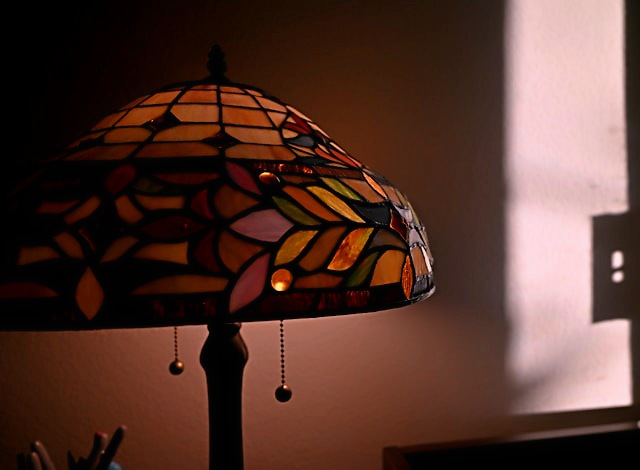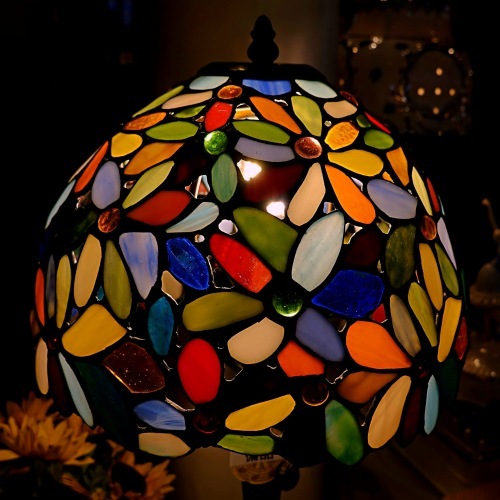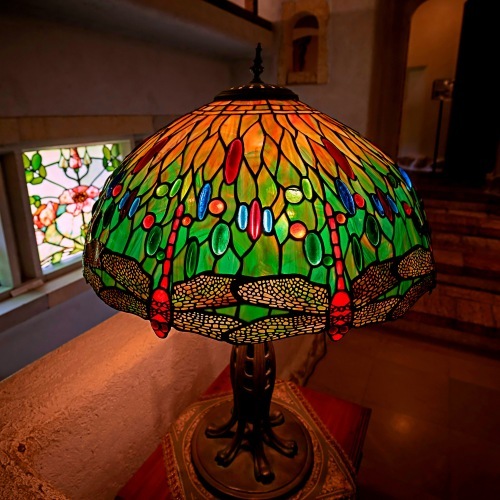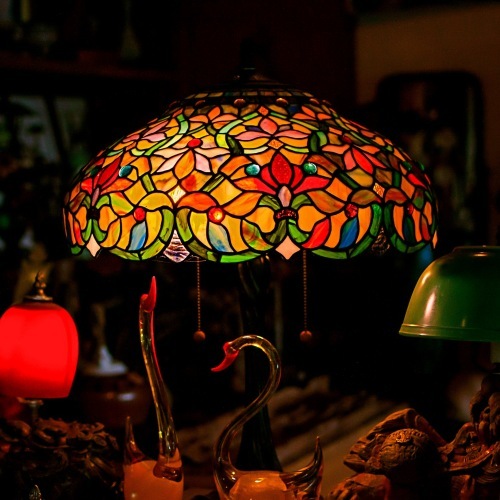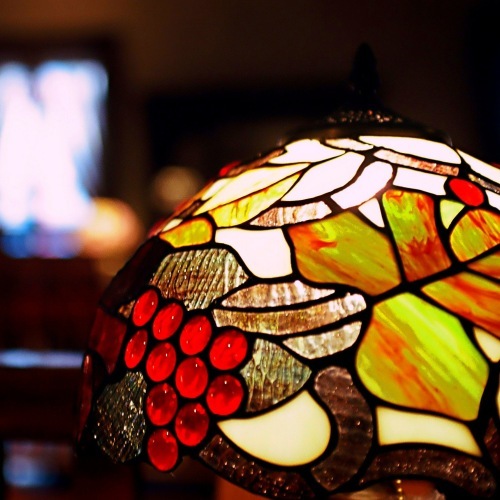The Timeless Art of Tiffany Lamps
The Tiffany lamp finds its origin in the late 19th century, envisioned by Louis Comfort Tiffany as a fusion of artistry and functionality. Drawing inspiration from Byzantine glasswork and Near Eastern mosaic traditions, Tiffany adapted and refined those aesthetics into vivid stained-glass designs that gained widespread acclaim after their debut at the 1893 Chicago World’s Fair. These lamps not only illuminated interiors – but also introduced a new era of decorative lighting which melded artistic sensibilities with practical design.
Louis Comfort Tiffany, son of famed jewelry magnate Charles Lewis Tiffany, was already a respected painter and interior designer when he turned his attention to glass. Dissatisfied with the flat, uniform panes of glass used in most stained-glass windows of the period, he pioneered the use of opalescent glass. This new medium allowed for richer tonal variations and a painterly quality that brought depth to his lighting designs. By combining innovation with artistic flair, Tiffany transformed ordinary light fixtures into enduring masterpieces that helped define the Art Nouveau movement.
Craftsmanship: Materials & Techniques
Each Tiffany lamp is a testament to skilled handcrafting. Artisans laboriously cut dozens – or even hundreds – of individual glass sections, meticulously chosen for hue, texture, and translucence. These pieces are assembled using the copper-foil method – wrapping each bit of glass in copper foil before soldering – to create a unified, luminous shade. The result is a mosaic-like composition that transforms light into vibrant, kaleidoscopic patterns, casting an enchanting ambiance in any space.
The copper-foil technique was revolutionary at the time, allowing for far more intricate designs than traditional leaded glass. This process enabled artisans to join even the smallest, most delicate shapes into cohesive works of art. The technique also gave Tiffany’s team greater flexibility in creating organic curves and lifelike depictions of plants, insects, and landscapes. Every lamp base was designed with equal care, often cast in bronze or sculpted to complement the shade’s imagery. This holistic attention to both structure and surface ensured that each lamp stood as a complete work of decorative art.
Iconic Styles and Forms
Tiffany lamps are celebrated for their broad stylistic range, and no two are exactly alike. While certain motifs became especially famous, the studio consistently pushed the boundaries of design, experimenting with new subjects and forms.
- Dragonfly and floral motifs: Detailed natural scenes with dragonflies, irises, or wisteria, brimming with organic elegance. These designs highlight Tiffany’s fascination with nature and reflect the broader Art Nouveau celebration of the natural world.
- Geometric patterns: Bold, abstract designs featuring squares, triangles, and fans – perfect for modern or art-deco interiors. Their symmetry offered an alternative for clients who preferred structure over botanical exuberance.
- Wisteria and foliage: Cascades of flowers and leaves rendered in rich stained glass – a classic and enduring aesthetic. The famous Wisteria lamp, for example, used over 2,000 pieces of glass to create its flowing canopy of blossoms.
These forms serve both functional purposes and visual storytelling, making Tiffany lamps prized as both lighting fixtures and decorative centerpieces. Whether serving as a desk lamp, floor lamp, or grand chandelier, their ability to transform an ordinary room into a gallery-like space remains unmatched.
Turkish vs. Tiffany Mosaic Lamps: How Do They Compare?
While Tiffany lamps in the West earned fame for their richly pictorial designs, Turkish mosaic lamps remain more geometric and oriental in aesthetic, emphasizing bold patterning and saturated color. Paykoc Imports’ lamps reflect those Ottoman influences, featuring tessellations, arabesques, and floral motifs set against jewel‑tone blues, reds, ambers, greens, and turquoises.
Unlike mass‑produced imitations, every standing lamp we offer is handcrafted in Turkey by artisans who trace their lineage through generations of mosaic makers. These craftsmen bring both ancestral skills and creative innovation to every piece.
Though both Tiffany and Turkish mosaic lamps are admired for their artistry, they emerge from different traditions and design philosophies. The table below highlights key differences between these two iconic lighting styles.
| Aspect | Turkish Mosaic Standing Lamps | Tiffany Floor Lamps |
|---|---|---|
| Origin | Ottoman Empire / Anatolia | United States, late 19th century |
| Design Focus | Geometric patterns, vivid colors, cultural motifs | Pictorial scenes, natural forms (flowers, insects) |
| Craftsmanship | Handmade by Turkish artisans using cut glass and beads | Stained glass soldered into copper foil frames |
| Color Palette | Bold jewel tones (reds, blues, ambers, greens) | Soft pastels and earth tones |
| Lighting Style | Warm, ambient glow with a kaleidoscopic effect | Focused downward lighting with decorative glow |
| Symbolism | Reflects Islamic and Ottoman heritage and patterns | Inspired by Art Nouveau and naturalist movements |
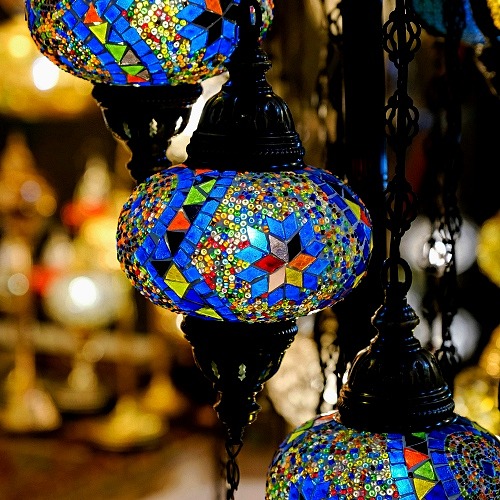
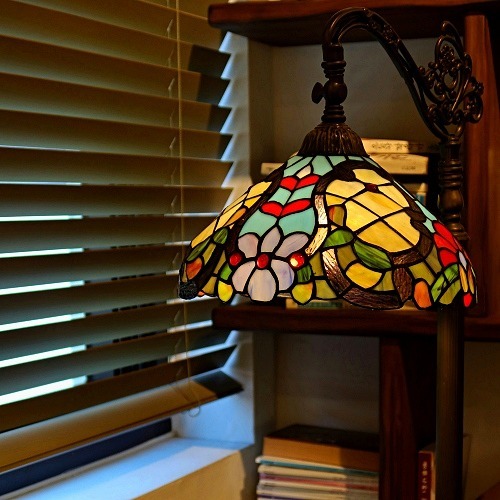
While Tiffany lamps in the West earned fame for their richly pictorial designs, Turkish mosaic lamps remain more geometric and oriental in aesthetic, emphasizing bold patterning and saturated color. Paykoc Imports’ lamps reflect those Ottoman influences, featuring tessellations, arabesques, and floral motifs set against jewel‑tone blues, reds, ambers, greens, and turquoises.
Unlike mass‑produced imitations, every standing lamp we offer is handcrafted in Turkey by artisans who trace their lineage through generations of mosaic makers. These craftsmen bring both ancestral skills and creative innovation to every piece.
Creating Ambience: Function and Placement
Tiffany lamps offer more than illumination – they imbue spaces with warmth, depth, and artistry. They provide a gentle, diffused glow rather than a harsh, utilitarian light, making them ideal for living rooms, studies, or foyers where ambiance takes precedence over task lighting. When strategically placed – on side tables, in reading corners, or as focal points on mantels – the glow from these lamps enriches the sensory experience of a room while drawing attention to their intricate craftsmanship.
Interior designers often use Tiffany lamps to introduce a sense of texture and historical depth to otherwise modern spaces. A single lamp can anchor a design scheme, tying together different colors in a room and providing a sense of continuity between furniture, textiles, and artwork. The lamp thus functions not only as lighting but as a curatorial object, lending character and sophistication to its surroundings.
Caring for Your Tiffany Lamp
To preserve the lasting beauty of a Tiffany lamp, a few simple maintenance steps can go a long way:
- Dust gently: Use a soft, dry cloth to remove surface dirt – avoid wet wipes or abrasive cleaners, which may damage the solder lines.
- Check wiring carefully: Ensure sockets, cords, and switches are in good condition and follow electrical safety guidelines.
- Avoid direct sunlight: Prolonged exposure may fade colors or weaken adhesives over decades.
- Professional restoration: If necessary, seek out specialized conservators to repair cracked glass or re-solder damaged joints.
Maintaining these lamps not only keeps them safe for daily use but also ensures that their artistry endures for future generations. Given the value and delicacy of authentic Tiffany pieces, proper care is an essential aspect of ownership.
Choosing the Right Tiffany Lamp for Your Space
Select a Tiffany lamp by harmonizing scale, color, and style with your décor. Balance is key: a small floral lamp can enliven a reading nook, while a more monumental geometric or landscape piece can anchor a sideboard or entry hall. Consider the overall lighting scheme – Tiffany lamps often function best as accents rather than primary sources of illumination. Pairing lamps or layering them with recessed lights and wall sconces can create a layered, inviting atmosphere.
Another factor to consider is the mood you wish to create. A dragonfly lamp with deep jewel tones will cast a dramatically different light than a pastel floral lamp, which lends a gentler, more romantic effect. By thoughtfully selecting your Tiffany lamp, you can personalize the character of your interior while celebrating one of design history’s greatest traditions.
Why Tiffany Lamps Still Resonate
Over a century after their creation, Tiffany lamps remain beloved for more than decorative flair. They invite viewers to slow down, observe color juxtaposition, and appreciate meticulous craftsmanship. In today’s digital age, their tactile beauty and handcrafted essence stand in stark contrast to mass-produced lighting – reminding us of a time when artistry and utility were inextricably linked. As iconic artifacts of design, Tiffany lamps continue to inspire artisans and captivate admirers, bridging past and present in glowing harmony.
Their continued popularity demonstrates that true artistry transcends trends. Whether displayed in a museum, a collector’s home, or a cozy living room, Tiffany lamps endure as radiant reminders of human creativity. More than functional lighting, they embody a philosophy that light itself can be art, capable of transforming spaces and enriching everyday life.

 Default Currency
Default Currency
